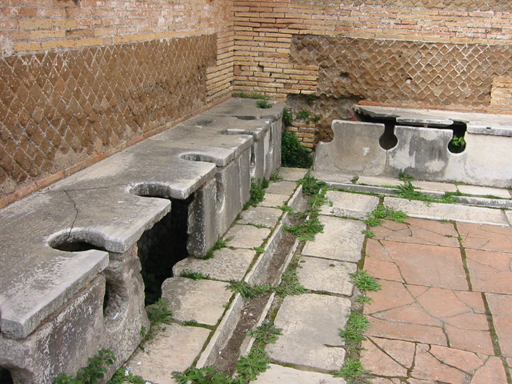1.4 Sharing a toilet
Toilets may date back to the Minoan civilisations on the island of Crete. From there they spread to other parts of the ancient Mediterranean, with the earliest ones in mainland Greece found in the fourth century BCE. These would be in private buildings, as well as public ones. In a private house, a toilet would be next to the kitchen, and would be ‘flushed’ by pouring water from the kitchen into it. This would then go down into a cesspit with the kitchen waste.
In addition, the Romans also had larger toilet buildings, with rows of toilet seats opposite each other for as many as 60 people. Most of these surviving Roman ‘communal’ toilets (foricae) are found in army bases or in conjunction with public baths. It’s possible that they were found near prestigious public buildings because the city officials were keen to keep their buildings clean, rather than for any other reason. These toilet buildings had a supply of running water which would carry waste away to the river. Today the idea of several dozen Romans sitting together on the toilet is very difficult to understand, but the nature of Roman male clothing may have made it relatively easy to maintain some privacy.
Concepts of privacy have changed over human history. The typical house in the West today has internal walls, but over time it has been more common for people to eat and sleep in the same room, often with their animals within the same walls. While rich people in the ancient world may have positioned their town houses so that others could not look in, most people in ancient Rome lived in cramped apartment blocks of three to five storeys high (insulae) with thin walls. Perhaps the lack of privacy in a shared toilet wasn’t a problem for them.
But just how sociable was it in the toilet? Although reconstructions often show men talking to each other, there is very little evidence on how one was expected to behave in a shared toilet. A few examples of board games etched between seats suggest a long stay; there are references in literary sources to graffiti, and paintings on the wall existed in some communal toilets. Would a long stay perhaps have been linked to people’s diet? It is not clear whether these toilet buildings were open or roofed, and this is relevant in terms of the amount of light. You would have needed some light to play a game, or see the paintings, if there were any. A popular subject for paintings in foricae was Fortuna, goddess of fortune!
As usual, literary sources are not always straightforward. The poet Martial wrote:
You read to me as I stand, you read to me as I sit,
You read to me as I run, you read to me as I shit.
Does this indicate normal behaviour, or instead someone who won’t leave him alone, even in the toilet where he expects to have some peace and quiet? The rest of the poem makes it clear that this is not how most people act, as the poet asks: ‘Do you wish to know why it is, Ligurinus, that nobody is glad to meet you?’
On the subject of long stays, Martial also mocks someone who hangs around in the public toilet in the hope of a dinner invitation:
Vacerra spends hours in all the privies, sitting all day long.
Vacerra doesn’t want a shit, he wants a dinner.
In some reconstructed toilets, in addition to the hole on which the user sits, there is another hole at the front of the seat. This may be for a man to urinate through, but is often interpreted in connection with the ‘sponge on a stick’, which you’ll look at next.

